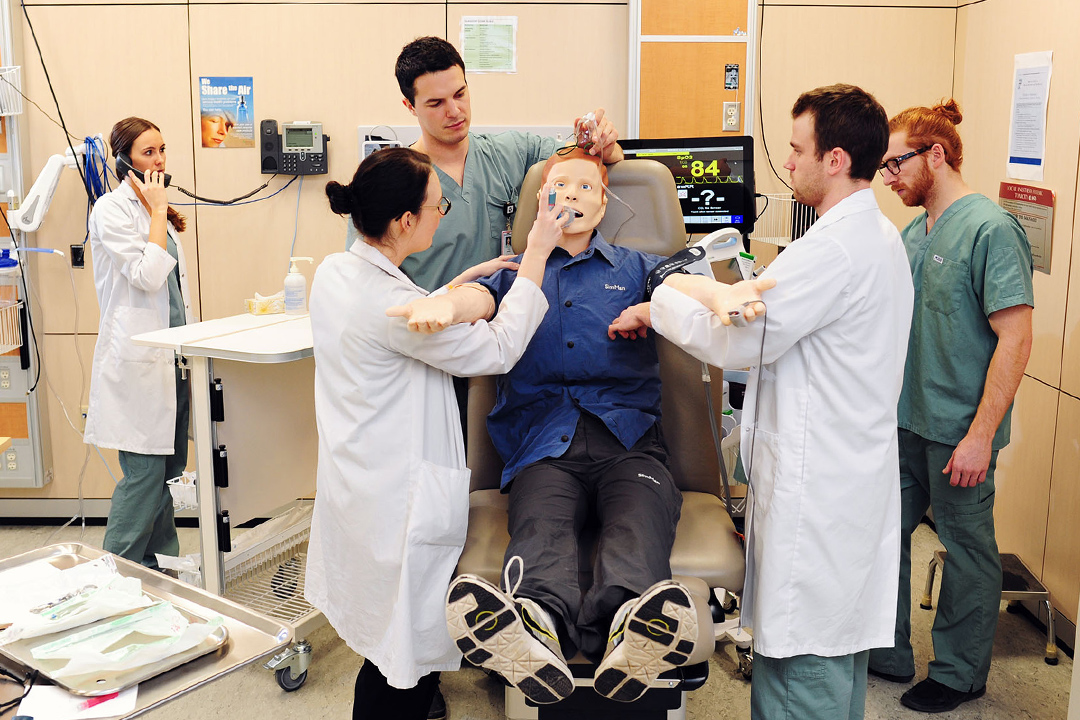
Preparing dental students for medical emergencies
Recent survey results show that practicing dentists in Saskatchewan face on average one medical emergency with a patient every 2.5 years.
By Colleen MacPhersonIt could be a heart attack, or a seizure, or a patient going into diabetic shock. Whatever the case, this reality raises the question: how prepared are dentists to respond when life and death may be on the line?
For Dr. Kabir Virdi, the numbers validate his efforts to ensure every graduate of the University of Saskatchewan College of Dentistry has the knowledge and, more importantly, the hands-on training necessary to deal with medical emergencies. To do that, he’s using one of the most unique and sophisticated simulation facilities in Canada—the Clinical Learning Resource Centre (CLRC).
“There had always been part of our courses dedicated to handling medical emergencies in the dental office,” said Virdi.
But when he joined the college in 2011 as an assistant professor of oral and maxillofacial surgery and took on the course directorship of undergraduate oral surgery, basic internal medicine and local anesthesia, he wanted to take a closer look at what the CLRC offers.
Located in the Health Sciences building adjacent to the college, and operated under the auspices of the university’s Office of the Vice-Provost, Health, the centre makes it possible for students from all health disciplines to apply their knowledge in a supervised simulated real-life environment.
“It’s fantastic,” said Virdi. “It’s the closest thing to practicing on a real live person and as far as we know, no one else is doing this kind of hands-on medical emergency training for dentistry students.”
Students still receive lectures on handling medical situations, but they now also get to apply their knowledge in the CLRC, and the scenarios they are presented with are eerily real.
Debbie Briere, CLRC manager, said the exam tables in the centre are adjustable so that the high-fidelity mannequins can be positioned precisely as a patient would be seated in a dental chair. The mannequins are dressed in street clothes rather than patient gowns, and props from the college, such as bibs, complete the picture. The simulation room is outfitted with an emergency kit, including simulated medication, based on the equipment recommendations of the College of Dental Surgeons of Saskatchewan.
“We try to provide all of the tools they would have in their practice to manage the situation,” said Briere. “Then, Dr. Virdi creates the problem he wants the students to manage and we work with him on how the mannequin would react. We also make sure the mannequin responds appropriately to interventions.”
Groups of five students are assigned roles for the simulation—a dentist, a dental assistant, a hygienist, a receptionist and a dental associate. The remaining students in the class watch events unfold in real time.
From behind a two-way mirror, Briere and Virdi control the mannequin’s vital signs and other indicators that signal an emergency. A microphone allows them to respond to questions as if the mannequin were talking, and Briere even consulted local emergency responders to create a 911 script so if students call for help (the call goes to the control room), the conversation they have will be authentic.
Virdi said the CLRC simulations put into practice everything the students heard in their lectures “but it also amalgamates their knowledge of medicine, pharmacology, physiology. It all comes together for them.”
Briere agrees. “They have these beautiful eureka moments.”
The circumstances of the scenarios can be changed on the fly, said Virdi, “which is exactly what you do for advanced trauma or cardiac life-support training. I train them for the worst, but even if they do everything right, I might ask that the mannequin go into cardiac arrest to see how they react.”
The main advantage to using simulations is that students can make mistakes without consequences, and an in-depth debriefing always follows. There, Virdi and Briere explore with the entire class what went well, why students made the decisions they did, and what each role player might have done differently.
Briere said that teaching teamwork and how to communicate in a crisis is as important as knowing the right interventions, because in a real emergency, a life could hang in the balance. Virdi added that while the focus has to be on patient safety, “to have something go wrong as a dentist is psychologically huge.”
The success of incorporating hands-on training has been borne out in a recent project. Students Ryan Brezinski and Codie Lambert worked with Virdi on a survey of fourth-year students before and after their training. The results show a statistically significant increase in their level of confidence at being able to handle a medical emergency.
Virdi said he timed the training very carefully—early in the second term—“because I want them to be ready before they graduate and do their board exams.”
As for next steps, Virdi said he will continue to refine the scenarios for dental students but he also wants to create opportunities for practicing dentists to hone their skills. To that end, the college will be holding a medical emergency seminar late next year.
This story appeared in the fall issue of Recall.
Colleen MacPherson is a Saskatoon-based freelance writer.

